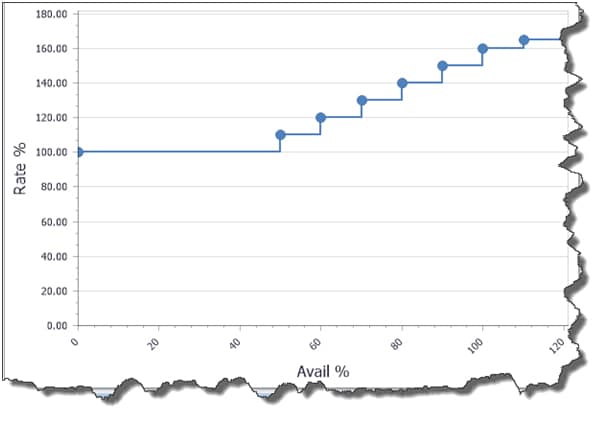Traffic & Sales Advice
Empower your Sales Team with Aquira’s advanced Rate Card Management now with the enhanced functionality to allow Rates to change as Inventory Demand fluctuates. We call it Demand Driven Rates.
In Aquira we have the luxury of Real Time Avails as documented in an earlier article. We also have a workflow and approval process for orders that allows the Sales Team to make revisions at any time during the lifecycle of their bookings.

In the above example the Rates begin increasing when 50% of Inventory is sold. The Rates at this point are increased by 10% from the Base Rate. From there Rates continue increasing at 10% increments.
With clients targeting their advertising for specific days which we refer to as “Fixed advertising,” Aquira can store Rates on individual days Monday through Sunday for each Station / Day Part / Spot Classification Combination. Aquira also allows all Stations with the same spot booking pattern to be booked on the same Spot Line saving Sales and Traffic time with data entry.
The concept of Supply and Demand was an idea that airlines used as a pricing model to encourage people to buy tickets in advance of travel. The closer you get to travelling, the higher the price of your tickets.
I found a fantastic booklet on Maximising Radio Station Revenue a former RCS Colleague of mine authored that explains this perfectly:
SUPPLY: The amount of any given commodity (potatoes, airline seats, radio commercial units) available for sale at any given time.
DEMAND: The willingness or ability of the customer to purchase a specific quantity of the commodity at a specific price at a certain time.
According to the Law of Supply and Demand, every change in either supply or demand should result in a price change. When a product is introduced, demand increases. Supply decreases as people buy more, so the price rises. When the product maker and their competitors take note of increasing demand they produce more, thus increasing the supply and holding or driving the price back down.
Some producers manipulate price by restricting supply to force prices up, or by dumping supplies at unusually low prices. Some producers manipulate demand by restricting supply or increasing advertising to stimulate desire for a product. Many broadcasters have felt that they have little say over the prices they can charge. Here are some of the things that affect your prices that you cannot directly control:
- The placement and return of survey results
- The business practices of your competitors
- An advertising agency’s Cost per Point goals
- The local and national economy
But there are only three elements that should really affect your prices, and you are in total control of almost all of them:
- You control supply by deciding how many commercials to run each hour.
- You control price by deciding what to charge, what to accept, and on what terms.
- You may not control demand, but you can respond to it, you can direct it, and you can influence it.
These are important concepts that can help you maximize your revenue. Let’s take a closer look at the ways you can “manipulate” demand to achieve positive revenue results.
Directing Demand
Airlines do this all the time. “Flight 703 to Los Angeles is full, but we do have another flight two hours later on the same day. May I book you on that?” Instead of adding another plane (increasing supply), they have directed your demand to another flight with less demand. You can direct demand by telling a customer, “Morning drive is not available on Friday at the rate you want. How about next Friday?”
Influencing Demand
Increasing supply could cause demand to decline. Cutting supply could cause demand, and price, to rise. In fact, most radio stations have already created favorable demand pressure by deciding to have a limited inventory. There are two things you can do to directly increase demand:
- Increase the number of advertisers who want to be on your station.
- Increase the amount of advertising they want to buy.
If the price you can charge is determined only by supply and demand, and your overall supply does not change, then increasing demand becomes the most important thing you can do to increase your revenues.
The new Demand Driven Rates feature in Aquira helps you increase your Rates as your Demand increases. If you would like to learn more about Aquira and other features it can offer please contact your local RCS Representative.